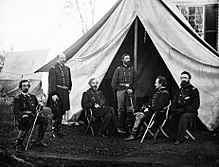George Sykes
George Sykes | |
|---|---|
 General George Sykes | |
| Nickname(s) | Tardy George Slow Trot Sykes |
| Born | October 9, 1822 Dover, Delaware |
| Died | February 8, 1880 (aged 57) Fort Brown, Texas |
| Place of burial | |
| Allegiance | United States of America Union |
| Service/ | United States Army Union Army |
| Years of service | 1842–1880 |
| Rank | |
| Commands held | V Corps 20th U.S. Infantry Regiment |
| Battles/wars | Second Seminole War Mexican–American War American Civil War |
George Sykes (October 9, 1822 – February 8, 1880) was a career United States Army officer and a Union general during the American Civil War.
He graduated from the
Sykes assumed command of the V Corps on June 28, 1863, following the promotion of Major General
Early life
Sykes was born in
Sykes was brevetted as a captain for actions at the Battle of Cerro Gordo. By virtue of his service in the Mexican War, Sykes became a member of the Aztec Club of 1847. Sykes continued his frontier service and Indian fighting, mainly in New Mexico, and was promoted to full captain in 1855. His final peacetime station was Fort Clark, Texas.
Civil War

At the outbreak of the Civil War, Sykes was assigned as a major in the new 14th U.S. Infantry. At the First Battle of Bull Run he commanded the Regular Infantry Battalion, a collection of eight regular army companies from different regiments, the only regulars on the field. Sykes got command of a brigade of regulars after Bull Run, and was promoted to brigadier general of volunteers on September 28. He led his regulars in the Peninsula Campaign and rose to division command in May 1862 in the newly created V Corps. His men, who often referred to themselves as "Sykes' Regulars", distinguished themselves defending their position at Gaines' Mill during the Seven Days Battles, before the Union line broke elsewhere.[2]
Sykes was notably the only division commander in the Army of the Potomac not rewarded with a promotion to major general after the Seven Days Battles. He continued leading his division at
Sykes' division was forced to retreat after being attacked on the right flank by Maj. Gen.

At the
On October 16, 1863, Sykes was promoted to lieutenant colonel in the regular army.
Sykes and his corps served in the
Postbellum career
After the war, Sykes was mustered out of the volunteer service and returned to serve in the regular army in 1866. As lieutenant colonel, he served in the 5th U.S. Infantry. Sykes was promoted to colonel on January 12, 1868 and received command of the 20th U.S. Infantry. He commanded at a number of duty stations from Minnesota to Texas until he died while on duty in Texas at Fort Brown on February 8, 1880, at age 57. He was interred in West Point Cemetery, West Point, New York.
His grandson,
See also
Notes
- ^ What About George. . .? [Sykes, That Is] 48th Pennsylvania Infantry. 11 August 2007. Web. Retrieved March 12, 2016.
- ^ a b c Tagg, p. 82.
- ^ The division had two regular brigades and one of volunteer infantry. Gouverneur K. Warren commanded that brigade for a time.
- ISSN 0362-4331. Retrieved 2022-01-30.
- ISSN 0362-4331. Retrieved 2022-01-30.
- ISSN 0362-4331. Retrieved 2022-01-30.
- ISSN 0362-4331. Retrieved 2022-01-30.
References
- Eicher, John H., and ISBN 0-8047-3641-3.
- Reese, Timothy J., Sykes' Regular Infantry Division, 1861–1864 a History of Regular United States Infantry Operations in the Civil War's Eastern Theater. Jefferson, N.C. : McFarland, 1990. ISBN 0-8995-0447-7.
- Tagg, Larry. The Generals of Gettysburg. Campbell, California: Savas Publishing, 1998. ISBN 1-882810-30-9.
- Warner, Ezra J. Generals in Blue: Lives of the Union Commanders. Baton Rouge: Louisiana State University Press, 1964. ISBN 0-8071-0822-7.
